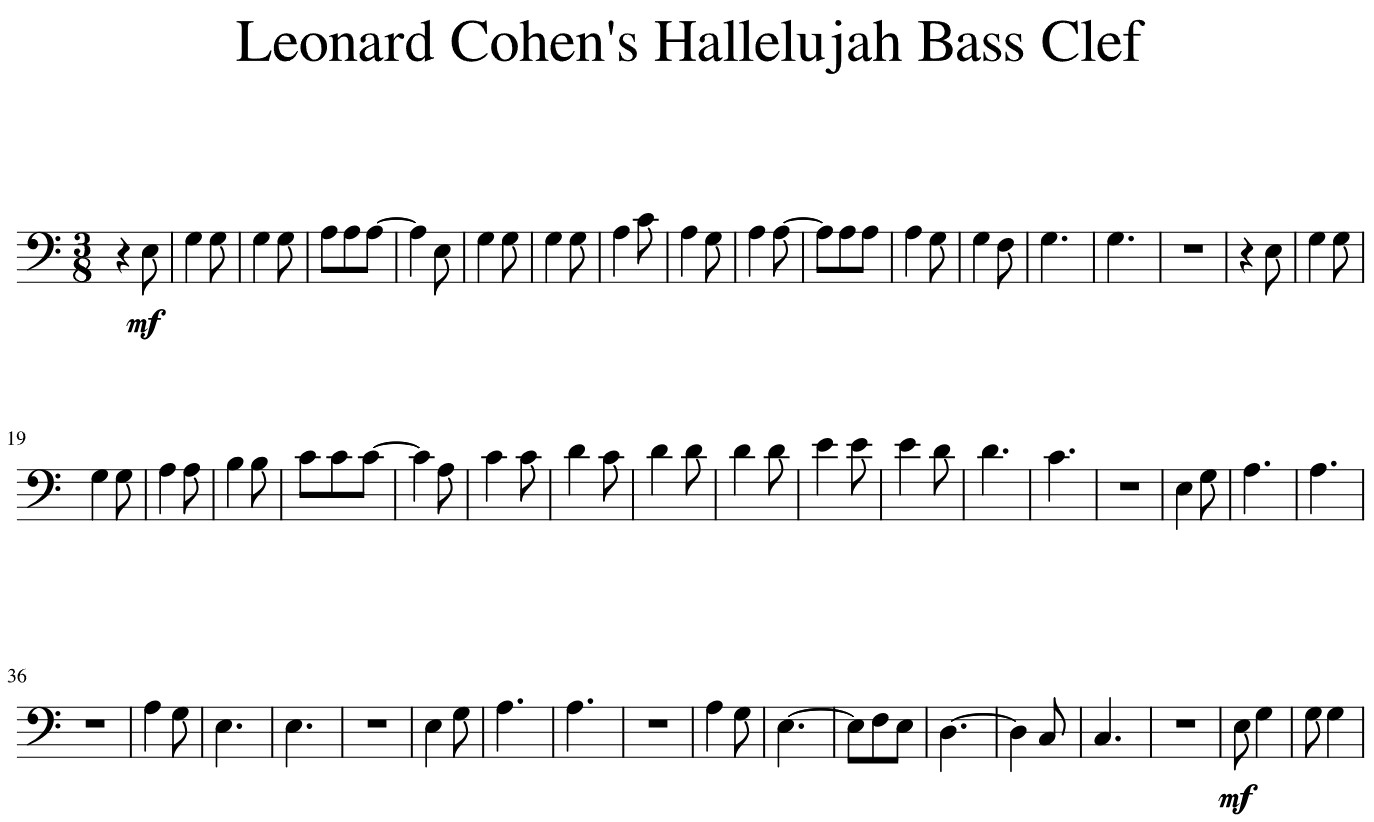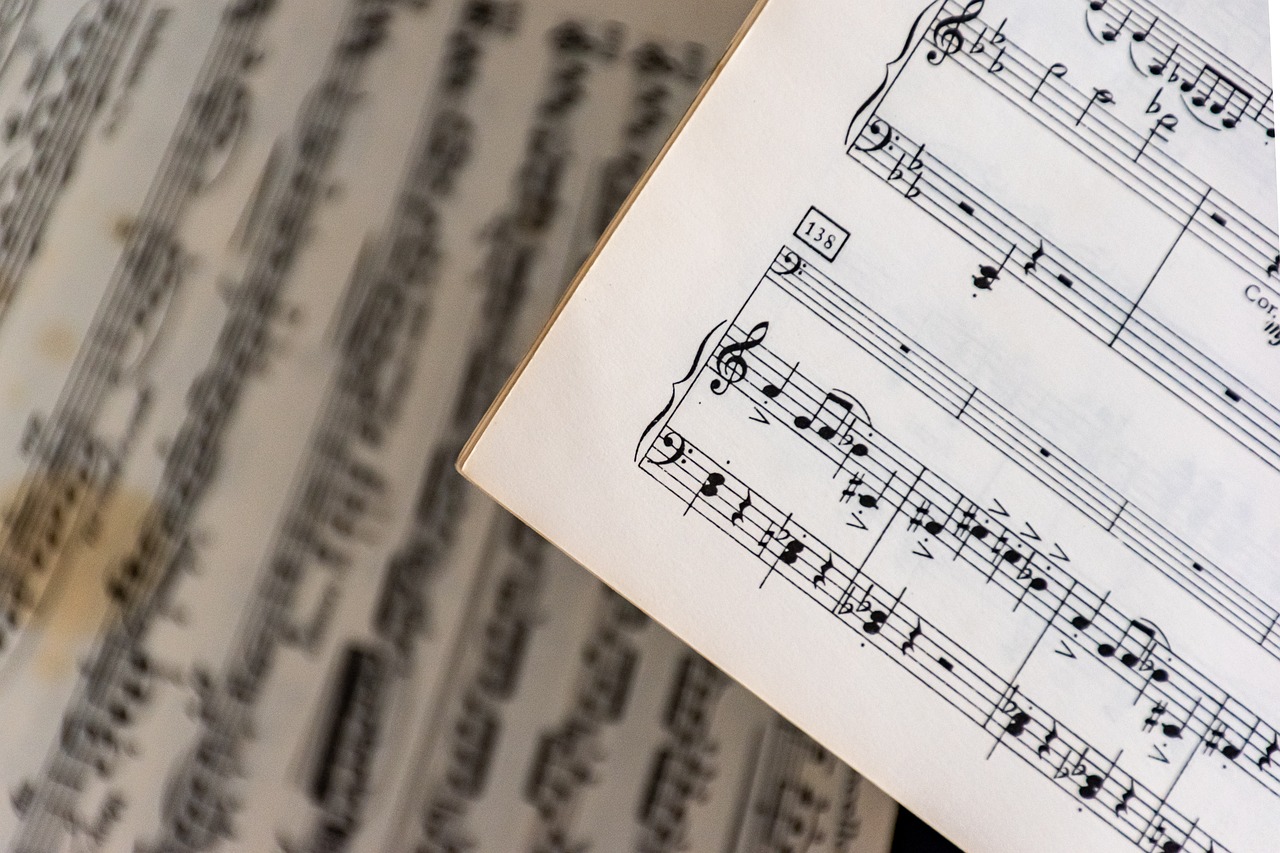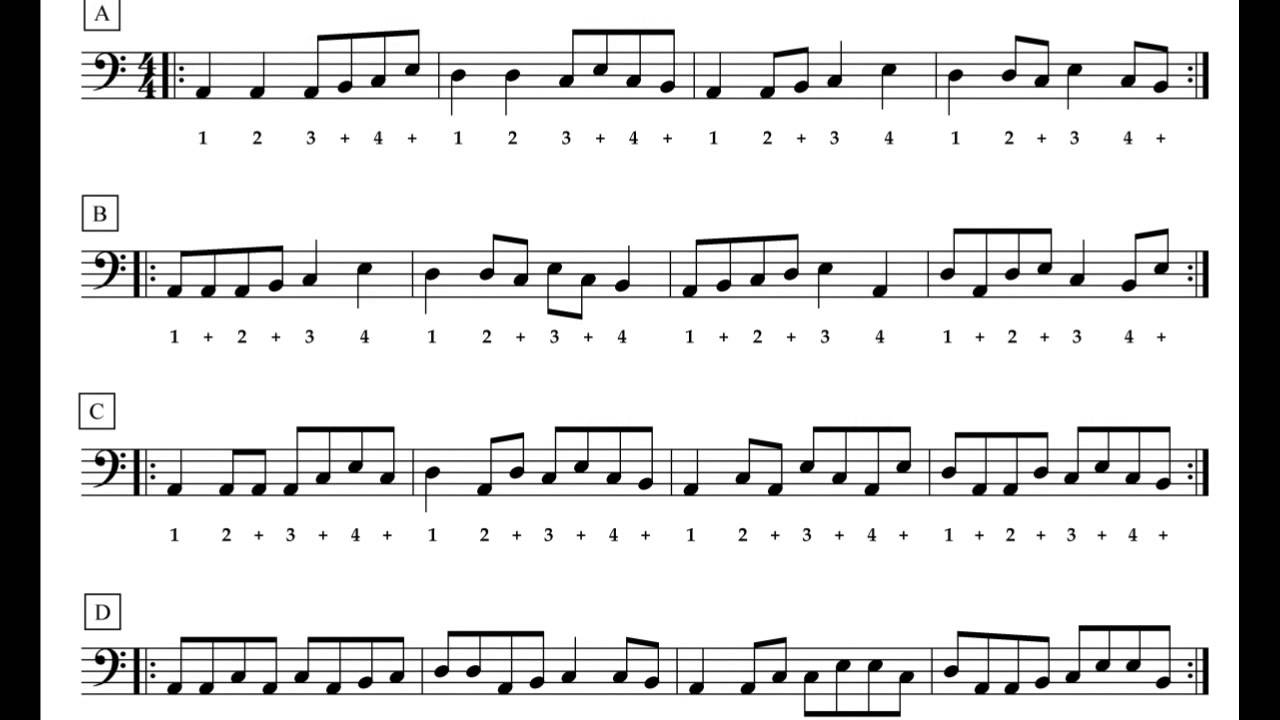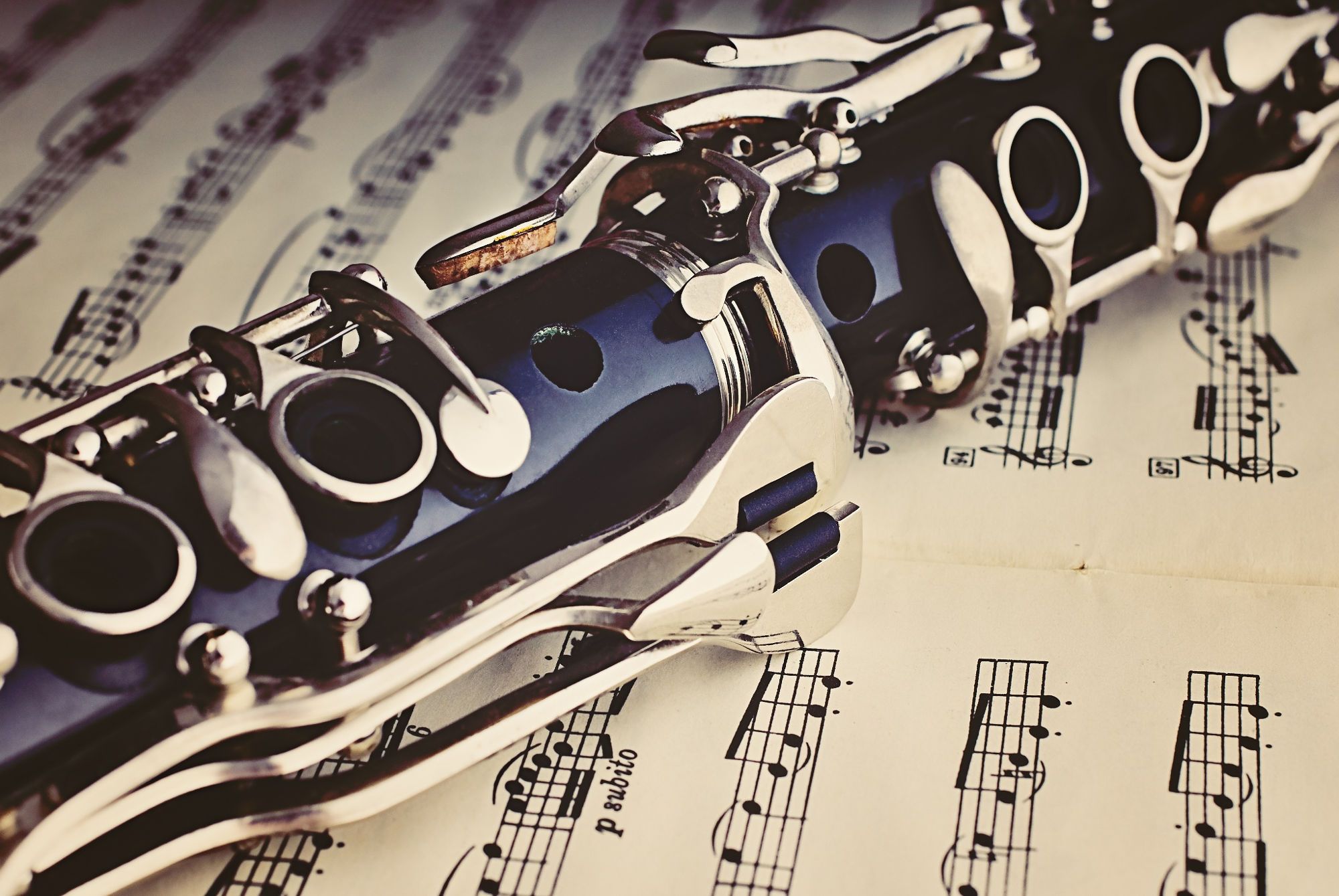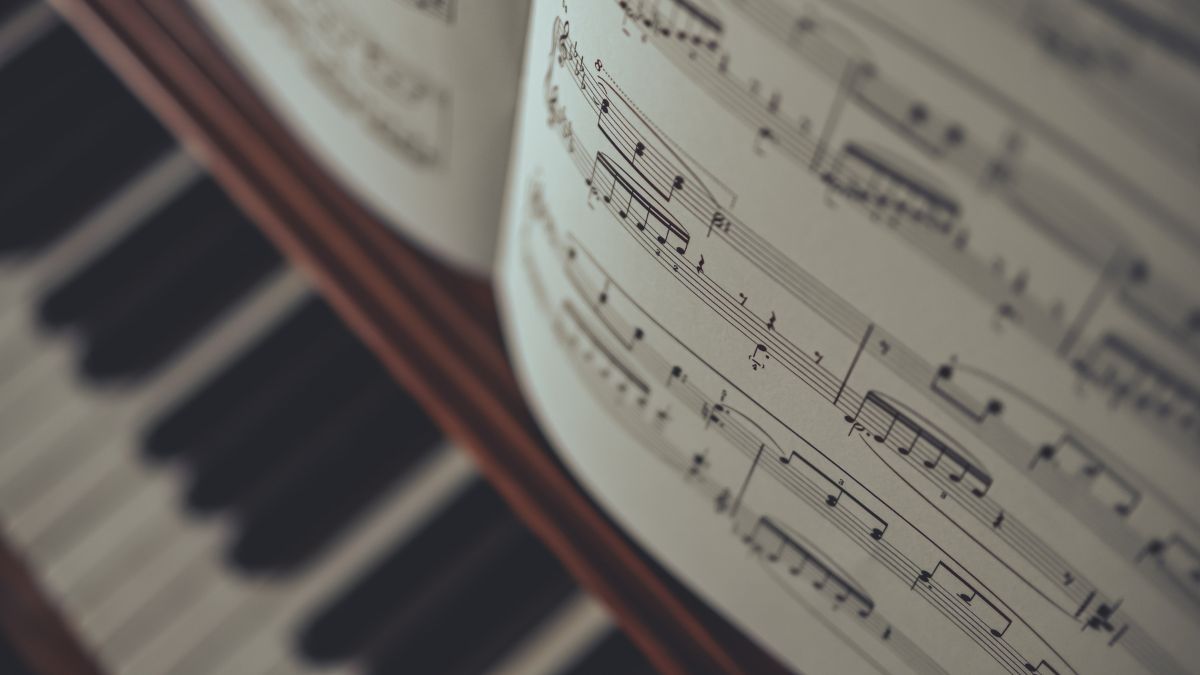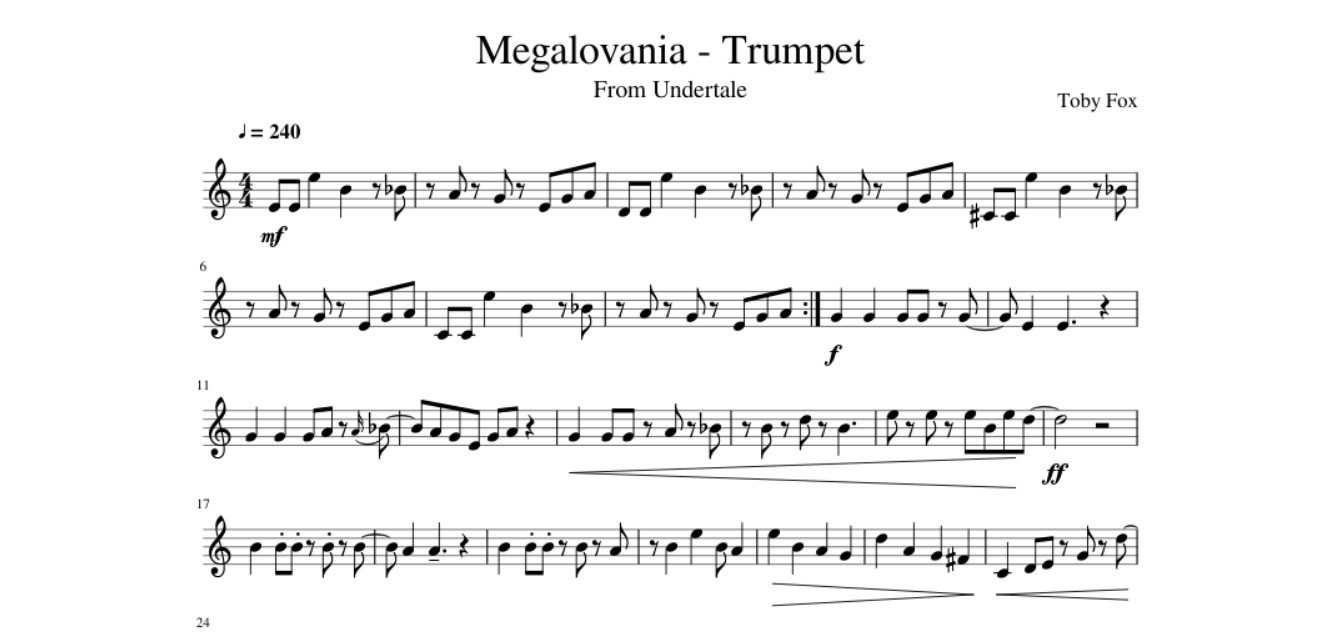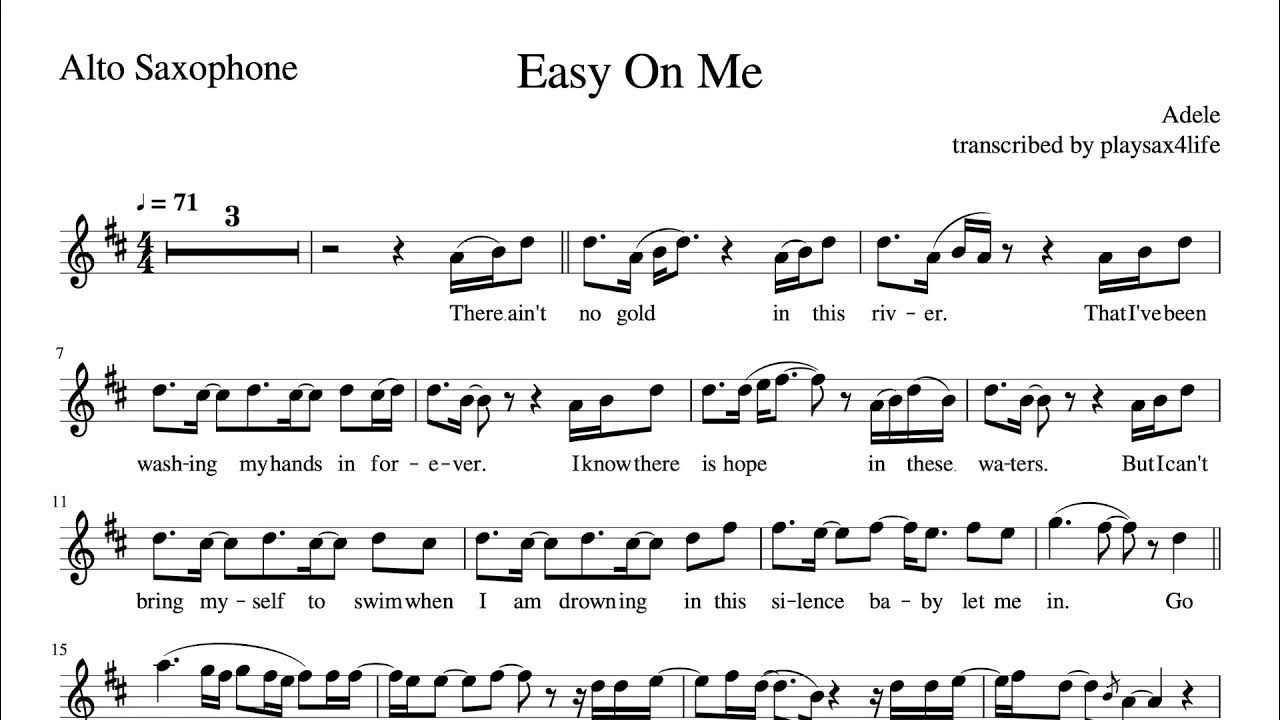Home>Events & Info>Note>How To Read A Music Note


Note
How To Read A Music Note
Modified: January 22, 2024
Learn how to read a music note and improve your musical skills. Discover tips and techniques for understanding musical notes and their significance.
(Many of the links in this article redirect to a specific reviewed product. Your purchase of these products through affiliate links helps to generate commission for AudioLover.com, at no extra cost. Learn more)
Table of Contents
- Introduction
- The Basics of Music Notation
- The Staff and Clefs
- Reading Note Names
- Understanding Rhythm
- Recognizing Note Durations
- Identifying Note and Rest Symbols
- Reading Music Dynamics
- Interpreting Musical Expressions
- Navigating Key Signatures
- Understanding Time Signatures
- Identifying Musical Symbols and Markings
- Sight Reading Exercises
- Conclusion
Introduction
Welcome to the wonderful world of music notation! Music notes are the written language of music, allowing musicians to communicate and express themselves through written scores. Whether you’re a beginner or an experienced musician, learning how to read music notes is an essential skill for any musician.
In this article, we will explore the basics of music notation and provide you with the tools to confidently read and interpret music notes. We’ll cover everything from note names and rhythm to key signatures and musical expressions. So, if you’ve ever wondered how to decipher those black dots on the page, you’ve come to the right place!
Reading music notes may seem overwhelming at first, with all the lines, symbols, and squiggly marks. However, with practice and a little guidance, you’ll find that reading music is like learning a new language – it becomes second nature with time.
Before we dive into the details, it’s important to note that music notation is a universal language. It doesn’t matter if you play the piano, guitar, violin, or any other instrument – the principles of reading music remain the same. So, no matter what instrument you’re learning or how experienced you are, this article will be a helpful resource for you.
Whether you’re interested in playing classical compositions, jazz improvisation, or even writing your own music, being able to read music notes opens up a world of possibilities. It allows you to learn new songs, play in ensembles, and communicate your musical ideas with others.
So, let’s get started on our journey to mastering the art of reading music notes. By the end of this article, you’ll have a solid foundation in music notation and be well on your way to becoming a proficient musician.
The Basics of Music Notation
Music notation is the visual representation of musical sounds. It provides a way to communicate musical ideas and instructions to performers. Understanding the basics of music notation is essential for reading and interpreting music notes accurately.
At its core, music notation consists of two key elements: the staff and the clefs. The staff is a set of horizontal lines and spaces where the notes are placed, while the clef determines the pitch range of the notes on the staff.
The staff is made up of five lines and four spaces, with each line and space representing a specific note. The lines and spaces are numbered, starting from the bottom line and moving upwards. By placing notes on different lines and spaces, we can represent different pitches.
There are three main types of clefs used in music notation: the treble clef, the bass clef, and the alto clef. The treble clef is commonly used for higher-pitched instruments like the piano, violin, and flute, while the bass clef is used for lower-pitched instruments like the bass guitar and cello. The alto clef is primarily used for instruments like the viola.
Once you understand the staff and the clefs, the next step is to learn how to read note names. Notes are represented by oval shapes placed on the lines and spaces of the staff. Each note corresponds to a specific pitch and duration.
Note names are represented by letter names, which are the first seven letters of the alphabet: A, B, C, D, E, F, and G. These letter names repeat in a continuous loop as the pitch gets higher or lower.
In addition to note names, music notation also includes other symbols to represent different aspects of music, such as rhythm, dynamics, and expressions. These symbols provide valuable instructions on how to play the music with the desired feeling and intensity.
Understanding the basics of music notation is crucial because it lays the foundation for reading and interpreting music scores accurately. With practice and familiarity, you will be able to read music notes with ease and confidence.
The Staff and Clefs
When you look at a piece of sheet music, you will notice a series of horizontal lines and spaces running across the page. This arrangement is known as the staff. The staff provides a framework for placing musical notes and symbols, allowing us to read and interpret the music accurately.
The staff consists of five horizontal lines and four spaces between them. Each line and space represents a specific pitch. The bottom line of the staff represents the lowest pitch, while the top line represents the highest pitch.
Notes are placed on the lines and spaces of the staff to indicate their pitch. The position of a note on the staff determines its pitch, with lower notes positioned lower on the staff and higher notes positioned higher on the staff.
To further specify the pitch range of a musical piece, different clef symbols are used. A clef is a symbol placed at the beginning of the staff, indicating the pitch range and position of the notes on the staff.
The three most commonly used clefs in Western music notation are the treble clef, bass clef, and alto clef.
The treble clef, also known as the G clef, is the most familiar clef and is used for higher-pitched instruments such as the piano, violin, and flute. It is identified by the curly line that wraps around the second line of the staff. The position of the treble clef on the staff indicates that the second line is the note G4.
The bass clef, also known as the F clef, is used for lower-pitched instruments like the bass guitar, cello, and double bass. It is identified by two dots placed above and below the fourth line of the staff. The position of the bass clef on the staff indicates that the fourth line is the note F3.
The alto clef is primarily used for instruments like the viola and the alto trombone. It is identified by a curve that intersects the third line of the staff. The position of the alto clef on the staff indicates that the third line is the note C4.
Understanding the staff and clefs is crucial for properly reading and interpreting written music. By recognizing the clef symbol at the beginning of a staff, you can quickly identify the pitch range and position of the notes. This knowledge forms the foundation for successfully reading music notes and playing them accurately on your instrument.
Reading Note Names
One of the fundamental skills in music notation is the ability to read note names. Note names are represented by the letters A, B, C, D, E, F, and G, which correspond to specific pitches on the musical staff.
The letter names A to G repeat in a continuous loop as the pitch gets higher or lower. This repetition allows us to navigate the musical staff and identify the notes accurately.
On the treble clef staff, the notes are positioned relative to the lines and spaces. The lines on the treble clef staff, from bottom to top, represent the notes E, G, B, D, and F. The spaces, from bottom to top, represent the notes F, A, C, and E.
On the bass clef staff, the lines and spaces represent different notes. The lines, from bottom to top, represent the notes G, B, D, F, and A. The spaces, from bottom to top, represent the notes A, C, E, and G.
Identifying note names on the staff requires practice and familiarity. By memorizing the position of the notes on the lines and spaces, you can quickly read the note names as you play or sing a piece of music.
In addition to the letter names, notes can also be altered with accidentals, such as sharps (#), flats (b), and naturals (♮). A sharp raises the pitch of a note by a half step, while a flat lowers the pitch by a half step. A natural cancels the effect of a sharp or flat, returning the note to its original pitch.
It’s important to pay attention to accidentals when reading note names, as they can significantly impact the melody and harmony of a piece of music.
Understanding how to read note names is a fundamental skill that allows musicians to accurately interpret and perform written music. By familiarizing yourself with the position of notes on the staff and recognizing accidentals, you can confidently navigate and interpret musical scores.
Understanding Rhythm
Rhythm is an essential aspect of music that gives it its unique pulse and groove. It refers to the arrangement of various note durations, rests, and rhythmic patterns within a piece of music. Understanding rhythm is crucial for accurately interpreting and performing music.
In music notation, rhythm is represented by different types of note durations and rests. Note durations indicate the length of time a note is held, while rests represent periods of silence or pauses.
The most common note durations include whole notes, half notes, quarter notes, eighth notes, and sixteenth notes. A whole note lasts for four beats, a half note for two beats, a quarter note for one beat, an eighth note for half a beat, and a sixteenth note for a quarter of a beat.
Rests, on the other hand, indicate moments of silence within a piece of music. Rests have the same durations as their corresponding notes. For example, a whole rest lasts for four beats, a half rest for two beats, a quarter rest for one beat, an eighth rest for half a beat, and a sixteenth rest for a quarter of a beat.
To understand rhythm fully, it’s important to learn how these different note durations and rests interact with each other. They can be combined and organized into patterns and measures, which are marked by vertical bars on the staff called bar lines.
The beats within each measure are divided by horizontal lines called beat divisions. The most common beat division is known as 4/4 time, also referred to as common time. In 4/4 time, there are four beats in each measure, and the quarter note represents one beat.
Other time signatures, such as 3/4, 6/8, or 2/2, indicate different rhythmic patterns and beats per measure. It’s essential to understand the time signature of a piece of music to interpret the rhythm correctly.
To read and perform rhythm accurately, it’s crucial to develop a strong sense of pulse and timing. Practicing with a metronome or tapping your foot can help you internalize the rhythm and maintain a consistent tempo.
Understanding rhythm is an essential skill for musicians. By mastering rhythm notation and developing a strong sense of timing, you’ll have the tools to bring music to life and create a compelling musical experience.
Recognizing Note Durations
In music notation, notes are not only represented by their pitch but also by their duration. Note durations indicate how long a note is held or sustained within a piece of music. By understanding note durations, you can accurately interpret the timing and rhythmic flow of a musical composition.
The most common note durations include whole notes, half notes, quarter notes, eighth notes, and sixteenth notes. Each note duration has a specific duration relative to a beat in the music.
A whole note lasts for four beats, making it the longest note duration. It is represented by an open oval shape on the staff.
A half note lasts for two beats, half the duration of a whole note. It is represented by a filled-in oval shape on the staff.
A quarter note lasts for one beat, which means it is half the duration of a half note. It is represented by a filled-in oval shape with a stem on the staff.
Eighth notes have half the duration of quarter notes, lasting for half a beat each. They are represented by filled-in oval shapes with stems and a flag on the end of the stem. When two eighth notes are connected by a horizontal bar, it is called a beam. The beam connects the notes visually, indicating that they are played together as one unit.
Sixteenth notes are even shorter in duration, lasting for a quarter of a beat. They are represented by filled-in oval shapes with stems and two flags on the end of the stem. Similar to eighth notes, sixteenth notes can also be connected with beams, visually grouping them together.
When notes have durations shorter than a sixteenth note, they are often notated with additional flags or beams, depending on their duration. These include thirty-second notes, sixty-fourth notes, and even smaller subdivisions.
It’s important to note that note durations can also be modified by adding dots to them. A dot placed after a note increases its duration by half. For example, a dotted half note lasts for three beats, and a dotted quarter note lasts for one and a half beats.
Understanding note durations is essential for accurately reading and performing music. By recognizing the different note shapes and their associated durations, you can effectively navigate the rhythm of a piece and maintain a steady tempo.
With practice, you will become more comfortable with recognizing and counting note durations, allowing you to play music with greater precision and musicality.
Identifying Note and Rest Symbols
As you delve into the world of music notation, you’ll encounter various symbols representing different elements of rhythm and timing. These symbols include note and rest symbols, which indicate the duration of sound and silence within a musical composition.
Note symbols represent the duration and pitch of a sounding note, while rest symbols represent periods of silence or pauses in the music. Understanding and identifying these symbols is crucial for accurately interpreting and performing written music.
Note symbols are represented by oval shapes placed on the lines and spaces of the staff. The position of the note on the staff determines its pitch, and the shape and stem direction indicate its duration.
Common note symbols include whole notes, half notes, quarter notes, eighth notes, and sixteenth notes. Whole notes are represented by open oval shapes, while half notes have a filled-in oval shape. Quarter notes have a filled-in oval shape with a stem, and eighth notes and sixteenth notes are represented by filled-in oval shapes with stems and flags attached. The number of flags or beams attached to the note determines its duration.
Rest symbols, on the other hand, represent periods of silence or pauses in the music. Rest symbols have the same durations as their corresponding note symbols. They are depicted by different shaped symbols placed on the lines and spaces of the staff.
Common rest symbols include whole rests, half rests, quarter rests, eighth rests, and sixteenth rests. Whole rests are represented by a rectangle sitting on top of the center line of the staff. Half rests are depicted by a rectangle resting on the middle line of the staff, while quarter rests have a curled shape below the middle line. Eighth rests and sixteenth rests have additional flags or beams attached to the curled shape.
As you read music, note and rest symbols will appear on the staff in combination with each other, indicating the rhythm and timing of the piece. By recognizing these symbols and associating them with their respective durations, you can accurately interpret and perform the music.
Practice is key to developing fluency in identifying note and rest symbols. As you engage with various musical pieces and exercises, your ability to recognize and interpret these symbols will improve over time.
By mastering the art of identifying note and rest symbols, you unlock the ability to accurately read and perform written music, enabling you to bring the composition to life with precision and musicality.
Reading Music Dynamics
Dynamics in music refer to the variations in volume or intensity within a piece. Understanding and interpreting the dynamics of a musical composition is essential for expressing the intended emotions and creating a dynamic performance.
In music notation, dynamics are indicated by specific terms and symbols that provide instructions on the desired volume or intensity level. These indications guide the musician in shaping the overall sound and expression of the music.
One of the most commonly used dynamic symbols is the dynamic marking “piano” (soft) and “forte” (loud). These symbols are represented by the letters “p” and “f” respectively. “Pianissimo” (very soft) and “fortissimo” (very loud) are indicated by “pp” and “ff”. These symbols are placed above or below the staff to indicate the desired dynamic level for a section or passage of music.
Other dynamic symbols include “mezzo piano” (moderately soft), “mezzo forte” (moderately loud), and “crescendo” (gradually getting louder) and “decrescendo” or “diminuendo” (gradually getting softer). These symbols notate changes in volume throughout the piece, allowing for expressive interpretation.
In addition to the dynamic symbols, musical notation also includes terms and phrases to describe the desired dynamics. For example, “pianissimo” is indicated by “pp”, but it is also written out as “very soft” in English. Similarly, “forte” can be indicated by “f” or written out as “loud”. These terms, in conjunction with the dynamic symbols, provide clarity and precision in communicating the desired dynamics.
Interpreting and executing dynamics is an integral part of musical expression. It requires sensitivity and control from the musician to accurately convey the musical intentions and bring out the desired emotions in the performance.
When reading music, it is essential to pay close attention to the dynamic markings written on the score. They provide important guidance for shaping the dynamics, creating contrast, and highlighting musical phrases and sections.
By observing and understanding the dynamic symbols and markings in a piece of music, you can effectively convey the intended loudness or softness, adding depth and emotion to your performance.
Remember that dynamics are not fixed, but rather dynamic markings provide a general guide. As a musician, you have the freedom to interpret and adjust the dynamics based on your artistic sensibilities and the style of the music.
Developing a keen awareness of music dynamics and effectively incorporating them into your playing will elevate your musical performances, invoking a range of emotions and captivating your audience.
Interpreting Musical Expressions
Music is not just a sequence of notes and rhythms; it is an expressive and emotional art form. Musical expressions convey the mood, character, and intentions of the composer, providing a roadmap for performers to interpret and communicate the music effectively.
Interpreting musical expressions involves understanding and conveying the nuances, phrasing, and stylistic elements embedded within a piece of music. It requires musicians to go beyond the written notes and connect with the underlying emotions and intentions behind the composition.
Musical expressions can be indicated through a variety of symbols, terms, and notations. These include markings for tempo, articulation, phrasing, dynamics, accents, and more.
Tempo markings, such as “allegro” (fast) or “adagio” (slow), provide guidance on the overall speed and pace of the music. Articulation markings, such as staccato or legato, define the way each note is played – whether short and detached or smooth and connected. Phrasing markings, such as slurs or phrase marks, indicate how musical phrases are grouped and shaped.
Dynamic markings, as discussed in the previous section, provide guidance on volume and intensity, allowing performers to create dynamic contrasts and shape the overall musical expression. Accents, indicated by the “>” symbol or the word “accent,” call for emphasis or stress on a particular note or passage.
Additionally, composers may include expressive terms to evoke specific emotions or musical styles. Terms like “agitated,” “joyful,” “mournful,” or “playfully” provide direction on the desired mood or character of the music.
Interpreting these musical expressions requires a combination of technical skill, musical knowledge, and artistic sensitivity. It’s important to study and understand the historical and cultural context of the music, as well as the musical style and conventions of the time.
Artistic interpretation also plays a significant role in expressing musical ideas. As performers, we have the opportunity to bring our own unique voice and personality to the music, adding personal nuances within the boundaries of the composer’s intentions.
Active listening and immersion in the music are paramount to successful interpretation. By studying recordings of renowned musicians, attending live performances, and listening attentively to a wide range of musical styles, you can expand your understanding of musical expression and develop your own interpretive skills.
Ultimately, interpreting musical expressions is a process of exploring, discovering, and connecting with the deeper meaning and emotional impact of the music. It allows us to breathe life into the notes on the page, engage with the audience, and create a profound musical experience.
Navigating Key Signatures
Key signatures play a crucial role in music notation as they provide valuable information about the tonality and tonal center of a piece. They indicate the sharps or flats that consistently appear throughout the composition, helping musicians navigate and interpret the music accurately.
A key signature is typically found at the beginning of a musical staff, right after the clef symbol. It consists of a series of sharps or flats placed on specific lines or spaces of the staff.
Key signatures are associated with specific major or minor keys. Major keys are characterized by a bright and cheerful sound, while minor keys often evoke a more melancholic or pensive mood.
Key signatures with sharps are related to major keys, while those with flats are associated with minor keys. For example, a key signature with one sharp corresponds to the key of G major or E minor, while a key signature with two flats represents the key of B-flat major or G minor.
Knowing the key signature allows musicians to anticipate the notes that are likely to be altered by sharps or flats throughout the piece. By internalizing the key signature, you can quickly identify and play the correct notes without having to notate the accidentals consistently.
It’s important to note that the order of sharps or flats in a key signature follows a specific pattern. For sharps, they appear in the order of F#, C#, G#, D#, A#, E#, and B#. For flats, they appear in the order of Bb, Eb, Ab, Db, Gb, Cb, and Fb.
When encountering a key signature, take a moment to identify the key and determine the starting pitch or tonal center. This will help you establish the appropriate tonality and guide your understanding of the harmonic structure of the music.
Navigating key signatures enhances both reading and playing music. By internalizing key signatures and understanding their impact on the arrangement of notes, musicians gain a deeper understanding of tonal relationships and can interpret the music with greater accuracy and confidence.
Regular practice and exposure to a variety of musical compositions in different keys will reinforce your ability to navigate key signatures and adapt to various tonalities. Over time, you’ll develop a heightened sensitivity to tonal centers and a more refined musical ear.
Key signatures are like signposts that guide musicians through the tonal landscape of a piece. Unlock the power of key signatures to unlock new musical possibilities and journey deeper into the world of music.
Understanding Time Signatures
Time signatures are fundamental notations in music that provide information about the organization of beats and rhythm within a piece. By understanding time signatures, musicians can establish a consistent pulse and interpret the rhythmic structure of the music accurately.
A time signature is typically displayed as a fraction, appearing at the beginning of a musical staff. The top number represents the number of beats in each measure, while the bottom number indicates the note value that receives one beat.
The most common time signature is 4/4, often referred to as “common time.” In 4/4 time, there are four beats in each measure, and the quarter note receives one beat. This time signature is widely used in various music genres and provides a steady and balanced rhythmic foundation.
Other common time signatures include 3/4, known as “waltz time,” where there are three beats in each measure, with the quarter note still receiving one beat. This time signature is frequently found in waltzes and gives the music a graceful and triple-meter feel.
6/8 is another common time signature, often associated with compound meters and a characteristic “dotted quarter – eighth note” pulse. In 6/8 time, there are six eighth notes in each measure, and the dotted quarter note receives one beat. This time signature is often used in lively and rhythmic pieces, such as jigs and certain folk and pop songs.
Time signatures can also have an irregular or mixed meter, where combinations of beat patterns stretch beyond the regular division of beats. For example, 7/8 time has seven eighth notes in each measure, providing a distinct and asymmetrical rhythmic quality.
To accurately interpret time signatures, it is important to establish a steady beat and understand how to subdivide the beats within the measure. This allows musicians to maintain a consistent tempo and navigate the rhythmic intricacies of the music.
Time signatures play a crucial role in shaping the overall feel and rhythmic structure of a piece. They provide a roadmap for musicians, enabling them to establish a sense of meter, accentuate musical phrases, and create rhythmic tension and release.
By familiarizing yourself with different time signatures and practicing various rhythmic patterns, you can develop a strong sense of rhythmic precision and versatility. This will enhance your ability to perform diverse musical styles and engage with complex rhythmic compositions.
Understanding time signatures is a key component of musical literacy and proficiency. With time and practice, you will be able to confidently interpret and navigate the rhythmic complexities of any piece of music, allowing you to bring out the true essence and rhythmical intricacies of the composition.
Identifying Musical Symbols and Markings
Music notation encompasses a rich array of symbols and markings that provide valuable information and instructions to musicians. These symbols and markings guide performers in conveying the desired expression, dynamics, articulation, and other musical elements to bring the composition to life.
One common set of symbols used in music notation is articulation markings. These symbols indicate how each note should be played, determining its duration and emphasis. Articulation markings include staccato dots, indicating short and detached notes, legato lines, indicating smooth and connected notes, and accents, indicating an emphasized or stressed note.
Dynamics markings are another essential component of music notation, indicating the volume and intensity of a particular section or passage. Symbols like “p” for “piano” (soft) and “f” for “forte” (loud) provide general indications, while other markings like “crescendo” (gradually getting louder) or “diminuendo” (gradually getting softer) add subtleties to the dynamics.
Phrasing and expression markings are used to shape musical phrases and convey specific musical ideas. Symbols such as slurs indicate that a group of notes should be played smoothly and connected, while phrase markings and phrasing slurs indicate the musical phrases and how they are to be shaped and phrased.
Other symbols and markings in music notation include tempo indications, such as “allegro” (fast) or “adagio” (slow), time signature changes, repeat signs, chord symbols, and more. These symbols and markings provide specific instructions that guide performers in accurately interpreting the composition and conveying the composer’s intentions.
It is important for musicians to familiarize themselves with these symbols and markings to effectively navigate and perform the music. Understanding their meanings and interpreting them correctly allows musicians to bring out the desired musical expression and communicate effectively with other performers.
Additionally, studying musical theory and historical context can help deepen your understanding of the symbols and markings utilized in a given piece. Each musical era may have specific notations and conventions, and being aware of these nuances aids in accurate interpretation.
As you encounter new symbols and markings in your musical journey, take the time to research and learn their meanings. Explore various musical scores and recordings to observe how different performers interpret and execute these symbols in their performances.
Identifying musical symbols and markings is an ongoing process that requires continuous learning and practice. By actively engaging with music notation, you will enhance your ability to interpret the markings with greater accuracy and bring greater depth and expression to your musical performances.
Sight Reading Exercises
Sight reading, the ability to play or sing a piece of music at first sight, is a valuable skill for musicians. It not only enhances your overall musicianship but also allows you to explore new repertoire and collaborate more effectively with other musicians. Incorporating sight reading exercises into your practice routine can significantly improve your ability to read and perform music on the spot.
Begin by selecting a piece of music that is appropriate for your skill level. It should challenge you, but not be overly difficult. Sight reading exercises can encompass a range of musical genres and styles, so try to explore diverse repertoire to broaden your musical horizons.
Start by looking at the key signature, time signature, and tempo markings. Take a moment to analyze the overall structure of the music, noting any repeated sections, changes in dynamics, or significant shifts in mood or style.
Before you start playing, silently examine the piece and mentally visualize the general melody, rhythm, and texture. Identify any challenging sections or technical passages that may require extra attention.
When you’re ready, begin playing the music at a slow and steady tempo. Focus on accuracy and rhythm, aiming to keep a consistent pulse throughout. It’s crucial not to stop or go back to correct mistakes. Instead, keep going, maintaining the flow of the music.
As you progress, pay attention to dynamics, articulation, and phrasing. Bring out the expressive markings and ensure that the music comes alive through your interpretation. Remember, sight reading is not just about playing the right notes; it’s also about capturing the essence of the music and conveying its emotions.
Consistency is key when practicing sight reading. Aim to incorporate regular sight reading exercises into your routine, gradually increasing the difficulty level as your skills improve. It’s also helpful to time yourself to simulate real-life performance situations and develop a sense of pacing.
Don’t be discouraged by mistakes or initial challenges. Sight reading is a skill that improves with practice. Take note of areas that need improvement and work on them specifically in subsequent practice sessions.
To enhance your sight reading abilities further, consider joining a sight reading group or ensemble. Collaborating with fellow musicians who are also honing their sight reading skills can provide valuable feedback and create a supportive learning environment.
Remember, sight reading exercises are meant to be challenging, but they also offer an exciting opportunity to discover new music and expand your repertoire. Embrace the process, celebrate your progress, and enjoy the journey of becoming a more confident and proficient sight reader.
Conclusion
Learning to read music notes is an invaluable skill for any musician. It opens up a world of musical possibilities, allowing you to play, interpret, and communicate through the universal language of music notation. Throughout this article, we’ve explored the essential aspects of music notation, from the basics of the staff and clefs to note names, rhythm, dynamics, and beyond.
By understanding the fundamentals of music notation, you gain the ability to navigate the intricacies of written music, interpret the composer’s intentions, and bring your own musical expression to the performance. Sight reading exercises and continuous practice can improve your ability to read and perform music on the spot, expanding your repertoire and enhancing your musicianship.
Remember, developing proficiency in reading music notes is a journey that requires dedication, patience, and regular practice. The more you immerse yourself in musical notation, the more comfortable and confident you will become in deciphering the language and interpreting the myriad symbols and markings.
Explore a diverse range of musical genres and styles, challenge yourself with new pieces, and seek opportunities to collaborate with fellow musicians. As you continue your musical journey, strive for a balance between technical precision and artistic interpretation, allowing the music to come alive through your playing.
Lastly, never forget the joy and wonder that music brings. Embrace the process, enjoy the discoveries, and let the magic of music ignite your passion and creativity.
So, grab your instrument or warm up your vocal cords, and dive into the world of reading music notes. With perseverance and dedication, you’ll unlock new musical horizons and cultivate a lifelong love for the art of reading and performing music.


